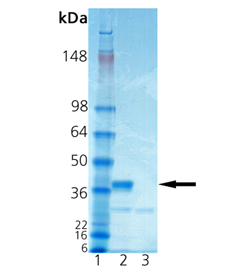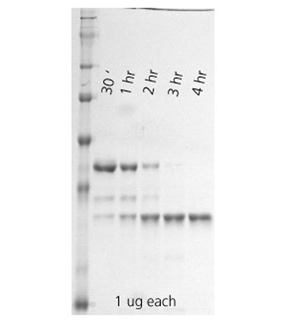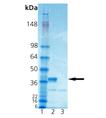Product Details
| Alternative Name: | Procathepsin O, Procathepsin O2, Procathepsin X |
| |
| MW: | 35.3kDa |
| |
| Source: | Produced in insect cells. Full length glycosylated human procathepsin K (also known as cathepsin O or cathepsin O2) cloned from human cDNA. Produced in a baculovirus expression system. |
| |
| EC: | 3.4.22.38 |
| |
| UniProt ID: | P43235 |
| |
| Formulation: | Liquid. In 27.8µl 20mM sodium phosphate, pH 6.9, 500mM NaCl, 1 mM EDTA. |
| |
| Purity: | ≥95% (SDS-PAGE) |
| |
| Purity Detail: | Purified by multi-step chromatography. |
| |
| Activity: | To activate proenzyme, add 32.5mM NaOAc, pH 3.5, to 20% of procathepsin K volume (e.g., 5µl procathepsin K + 1µl 32.5mM NaOAc, pH 3.5), and incubate at room temperature for 25-30 minutes, or at +4°C for approximately seven hours. |
| |
| Application Notes: | Useful tool to study enzyme kinetics, cleave target substrates and screen for inhibitors. |
| |
| Shipping: | Dry Ice |
| |
| Long Term Storage: | -80°C |
| |
| Use/Stability: | -80°C. After initial defrost, aliquot product into individual tubes and refreeze at -80°C. Avoid repeated freeze/defrost cycles and extended periods unfrozen. This enzyme is stable when stored as received under the above conditions. Procedures such as dilution of the enzme followed by refreezing could lead to loss of activity. |
| |
| Handling: | Avoid freeze/thaw cycles. After opening, prepare aliquots and store at -80°C. |
| |
| Scientific Background: | Cathepsin K, a member of the papain family of cysteine proteases, acts upon proteins such as collagen, AL amyloid, kinin and elastin. It is a lysosomal protease expressed primarily in osteoclasts, but also in other cell types such as macrophages. It functions in bone remodeling and is implicated in disease states such as atherosclerosis, arthritis and pycnodysostosis. |
| |
| Regulatory Status: | RUO - Research Use Only |
| |

SDS-PAGE Analysis: Lane 1: MWM; Lane 2: 1.0 µg of purified Procathepsin K; Lane 3: 1.0 µg Cathepsin K after activation at low pH for 3 hours.

Activation of procathepsin K at 22°C. Lane 1, size marker. Lane 2, 0.5 hour. Lane 3, 1 hour. Lane 4, 2 hours. Lane 5, 3 hours. Lane 6, 4 hours. 1 ug per lane, loaded after EtOH precipitation/wash and resuspension in SDS-PAGE sample buffer.
Please mouse over
Product Literature References
Two Tags in One Probe: Combining Fluorescence- and Biotin-based Detection of the Trypanosomal Cysteine Protease Rhodesain: C. Lemke, et al.; Chemistry
28, e202201636 (2022),
Abstract;
General Literature References
Cathepsin K-dependent toll-like receptor 9 signaling revealed in experimental arthritis.: M. Asagiri et al.; Science
319, 624 (2008),
Abstract;
Cathepsin K: a cysteine protease with unique kinin-degrading properties.: E. Godat et al.; Biochem. J.
383, 501 (2004),
Abstract;
Cathepsin V, a novel and potent elastolytic activity expressed in activated macrophages.: Y. Yasuda et al.; J. Biol. Chem.
279, 36761 (2004),
Abstract;
Cleavage of AL amyloid proteins and AL amyloid deposits by cathepsins B, K, and L.: S. Bohne et al.; J. Pathol.
203, 528 (2004),
Abstract;
Design of noncovalent inhibitors of human cathepsin L. From the 96-residue proregion to optimized tripeptides.: S.F. Chowdhury et al.; J. Med. Chem.
45, 5321 (2002),
Abstract;
Cathepsin K--a marker of macrophage differentiation?: F. Buhling et al.; J. Pathol.
195, 375 (2001),
Abstract;
Interdependency of sequence and positional specificities for cysteine proteases of the papain family.: D.K. Nagler et al.; Biochemistry
38, 4868 (1999),
Abstract;
The collagenolytic activity of cathepsin K is unique among mammalian proteinases.: P. Garnero et al.; J. Biol. Chem.
273, 32347 (1998),
Abstract;
Major increase in endopeptidase activity of human cathepsin B upon removal of occluding loop contacts.: D.K. Nagler et al.; Biochemistry
36, 12608 (1997),
Abstract;
Cathepsin K, but not cathepsins B, L, or S, is abundantly expressed in human osteoclasts.: F.H. Drake et al.; J. Biol. Chem.
271, 12511 (1996),
Abstract;
Pycnodysostosis, a lysosomal disease caused by cathepsin K deficiency.: B.D. Gelb et al.; Science
273, 1236 (1996),
Abstract;
Human cathepsin O2, a novel cysteine protease highly expressed in osteoclastomas and ovary molecular cloning, sequencing and tissue distribution.: D. Bromme & K. Okamoto; Biol. Chem. Hoppe Seyler
376, 379 (1995),
Abstract;
Related Products














